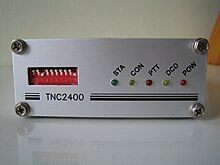
Back Packet radio Catalan Packet radio Czech Packet radio Danish Packet Radio German Paket-radio Esperanto Packet (Radio) Spanish Packet radio French Radio Paket ID Packet radio Italian パケット通信 (アマチュア無線) Japanese

In digital radio, packet radio is the application of packet switching techniques to digital radio communications. Packet radio uses a packet switching protocol as opposed to circuit switching or message switching protocols to transmit digital data via a radio communication link.
Packet radio is frequently used by amateur radio operators. The AX.25 (Amateur X.25) protocol was derived from the X.25 data link layer protocol and adapted for amateur radio use. Every AX.25 packet includes the sender's amateur radio callsign, which satisfies the US FCC requirements for amateur radio station identification. AX.25 allows other stations to automatically repeat packets to extend the range of transmissions. It is possible for any packet station to act as a digipeater, linking distant stations with each other through ad hoc networks. This makes packet radio especially useful for emergency communications.
Packet radio can be used in mobile communications. Some mobile packet radio stations transmit their location periodically using the Automatic Packet Reporting System (APRS). If the APRS packet is received by an "igate" station, position reports and other messages can be routed to an internet server, and made accessible on a public web page. This allows amateur radio operators to track the locations of vehicles, hikers, high-altitude balloons, etc., along with telemetry and other messages around the world.
Some packet radio implementations also use dedicated point-to-point links such as TARPN. In cases such as this, new protocols have emerged such as Improved Layer 2 Protocol (IL2P) supporting forward error correction for noisy and weak signal links.
© MMXXIII Rich X Search. We shall prevail. All rights reserved. Rich X Search